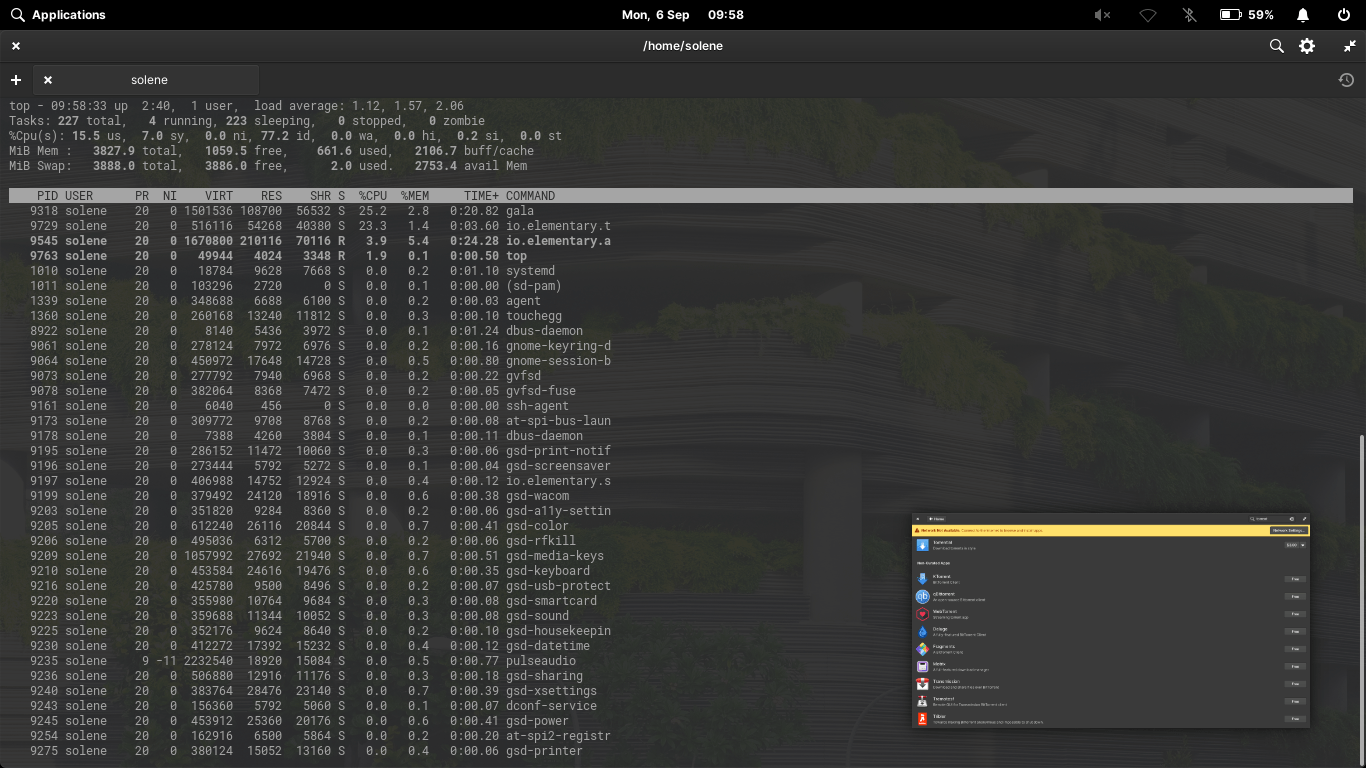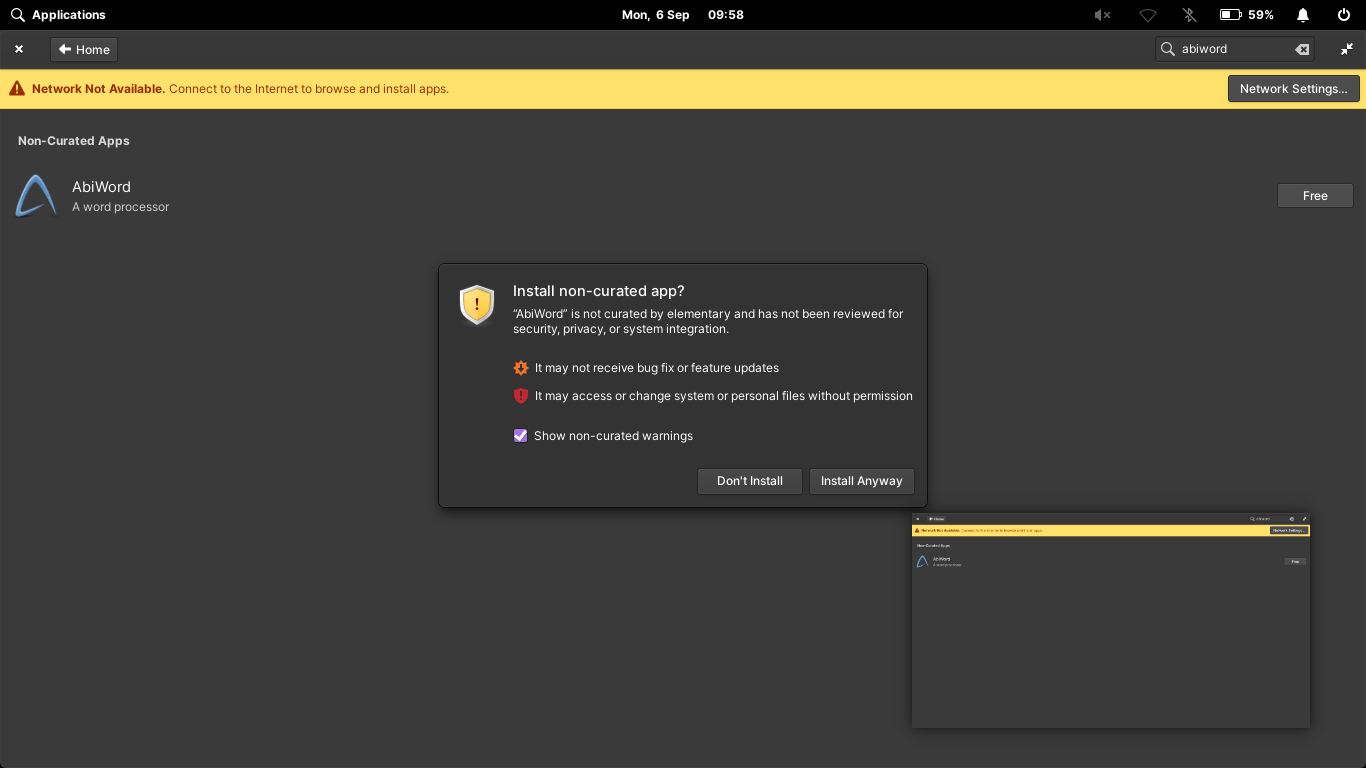| Title: Review of ElementaryOS 6 (Odin)
Author: Solène
Date: 06 September 2021
Tags: linux review
Description:
# Introduction
ElementaryOS is a linux distribution based on Ubuntu that also ship
with a in-house developed desktop environment Pantheon and ecosystem
apps. Since their 6th release named Odin, the development team made a
bold choice of proposing software through the Flatpak package manager.
I've been using this linux distribution on my powerful netbook (4 cores
atom, 4 GB of memory) for some weeks, trying not to use the terminal
and now this is my review.
|
| ElementaryOS project website |
| |
| 
|
|
# Pantheon
I've been using ElementaryOS a little in the past so I was already
aware of the Pantheon desktop when I installed ElementaryOS Odin on my
netbook, I've been pleased to see it didn't change in term of
usability. Basically, Pantheon looks like a Gnome3 desktop with a nice
and usable dock à la MacOS.
Using the Super key (often referred to as the "Windows key") and you
will be disappointed by getting a window with a list of shortcuts that
works with Pantheon. Putting the help on this button is quite clever
as we are used to press it for sending commands, but after a while it's
misleading to have a single button triggering help, fortunately this
behaviour can be configured to display the desktop or the applications
menu.
Pantheon has a very nice feature I totally love which create a floating
miniature of a target window that stay on top of everything, I often
need to keep an eye on a window or watch a movie, and this mode allow
me to exactly do that. The miniature is easy to move on the screen,
easy to resize, and upon a click the window appears and the miniature
is then hidden until you switch to another window. It may seems a
gadget, but on a small screens I really appreciate. You can create
this for a window by pressing Super+f and clicking on a target.
|
| 
|
|
The desktop comes with some programs made specifically for Pantheon:
terminal emulator, file browser, text editor, calendar etc... They are
simple but effective.
The whole environment is stable, good looking, coherent and usable.
# The AppCenter and Flatpak
As I said before, ElementaryOS is based on Ubuntu so it inherits all
the packages available on Ubuntu, but they will be only installable
from the command line. The Application center GUI shows an entirely
different package sets that comes from the ElementaryOS flatpak
repository but also the one from flathub. Official repository apps are
clearly designated as official while programs from flathub will be
displayed as third party and a warning about quality/security will be
displayed for each program from this repository when you want to
install.
|
| 
|
|
Flatpak has a pretty bad reputation among the groups I regularly read,
however I like flatpak. Crash course to flatpak: it is a Linux
agnostic package manager that will not reuse your system library but
instead install the whole basics dependencies required (such as X11,
KDE, Gnome etc...) and then programs are installed upon this, but still
separated from each other. Programs running from flatpak will have
different permissions and may be limited in their permissions (no
network, can only reach ~/Downloads/ etc..), this is very nice but not
always convenient especially for programs that require plugins. The
whole idea of flatpak is that you install a program and it shouldn't
mess with the current system, and it can be installed in such way that
when you use it, the person making the program bundle can restrict the
permissions as much as wanted.
While installing flatpak programs take a good amount of data to
download because of the big dependencies, you need them only once and
updating flatpak programs will use delta changes, so only difference is
downloaded, I found updates to be very small in regards to network
consumption. While installing a single GUI app from flatpak on a Linux
system can be seen as overkill, the small Gemini browser Lagrange
involve more than 1GB of dependencies from flatpak, it totally make
sense to install everything needed by the user from flatpak.
If you are unhappy with the current permissions of a program, you can
use the utility Flatseal to tweak its permissions, which is very cool.
I totally understand and love the move to full flatpak, it has proven
me to be solid, easy to use and easy to tweak despite flatpak still
being very young. I liked very much that my Firefox on OpenBSD had the
unveil feature preventing it from accessing my data in case of security
breach, now with Firefox from Flatpak or Firefox run from firejail I
can get the same on Linux. There is one thing I regret in the
AppCenter though but this is my opinion and I can understand why it is
so, some programs have a priced button like "3,00$" while the other are
"Free", there is a menu near the price that let you choose the amount
you want to pay but you can also put 0,00 and then the program is free.
This can be misleading for users because the program is actually free
but in "pay what you want" mode.
|
| 
|
|
I have no issues paying for Free software as long as it's 100% free,
but suggesting a price for a package while you don't know you can
install it for free can be weird. The payment implementation of the
AppCenter could be the beginning of paid software integrated into
ElementaryOS, I have no strong opinion about this because people need
money for a living, but I hope it will be used wisely.
# No terminal challenge
While trying ElementaryOS for some time, I gave myself a little
challenge that was to avoid using the Terminal as much as possible. I
quite succeeded as I only required a terminal to install a regular
package (lutris, not available as flatpak). Of course, I couldn't
prevent myself to play with a terminal to check for bandwidth or CPU
usage but it doesn't count as a normal computer use.
Everything worked fine so far, network access, wireless, installing and
playing video games, video players.
I'd feel confident if I recommended a non linux users to install
ElementaryOS and use it. On first boot the system provides a nice
introduction to explain basics.
# Parental control
This is a feature I'm not using but I found it in the configuration
panel and I've been surprised to see it. ElementaryOS comes with a
feature to restrict time in week days and week-end days, but also
prevent an user to reach some URLs (no idea how this is implemented)
and also forbid to run some installed Apps.
I don't have kids but I assume this can be very useful to prevent the
use of the computer past some time or prevent them to use some
programs, to make it work they would obviously need their own account
and not able to be root. I can't judge if it works fine, if it's
suitable for real world, but I wanted to share about this unique
feature.
|
| 
|
|
# Global performance
My netbook proved to be quite okay to use Pantheon. The worse cases I
figured out are displaying the applications menu which takes a second,
and the AppCenter that is slow to browse and the "searching for update"
takes a long time.
As I said in the introduction, my Netbook has a quad core atom and a
good amount of memory but the eMMC storage is quite slow. I don't know
if the lack of responsiveness comes from my CPU or storage, but I can
tell everything works smoothly on an older Core2 Duo!
# Conclusion
Using ElementaryOS was delightful, it just works. The team made a very
good work for the whole coherence of the desktop. It is certainly not
the distribution you need when you want full control or if you want
something super light, but it definitely does the job for users that
just want things to work, and who like Pantheon. It doesn't seem
straightforward to switch to another desktop environment. |




